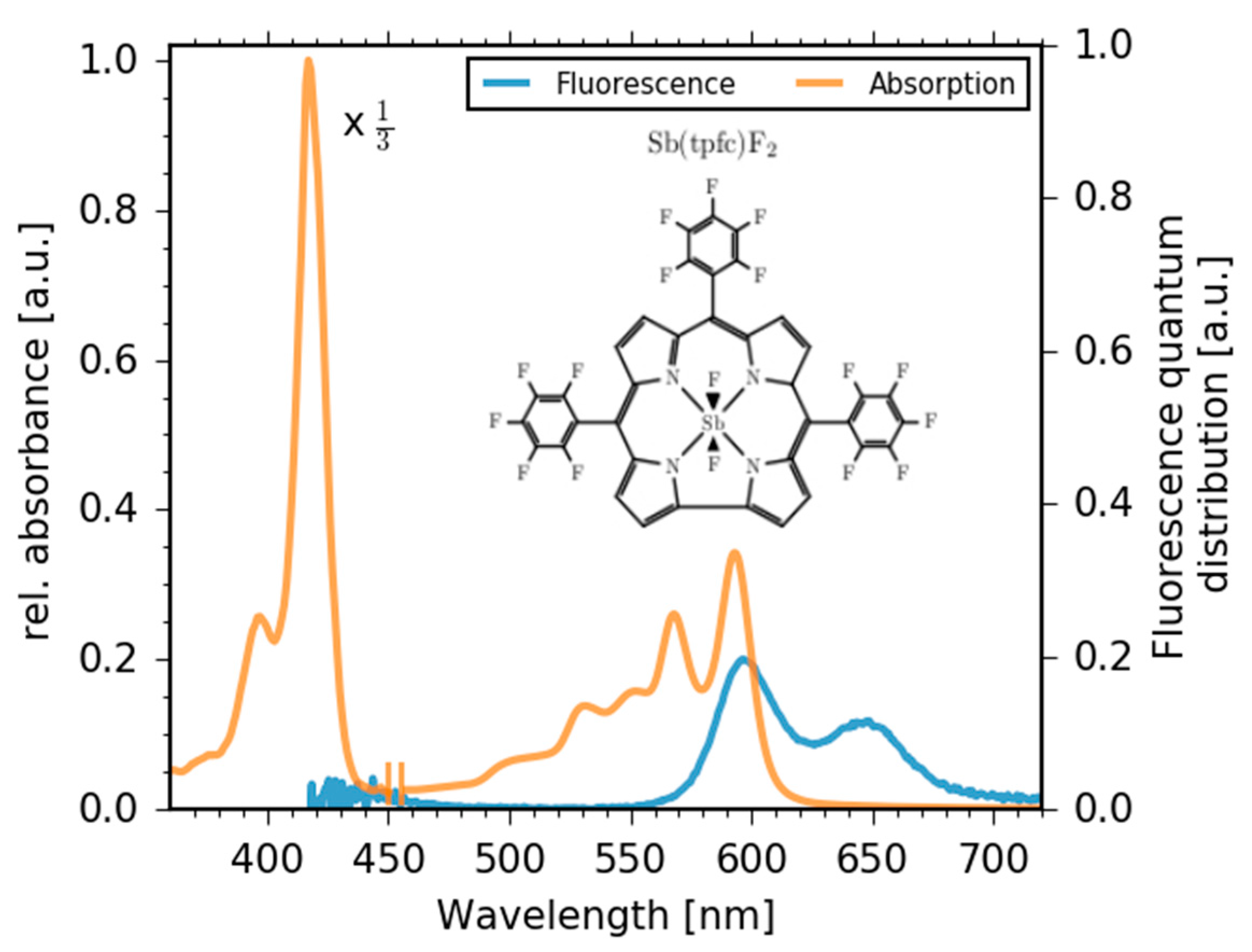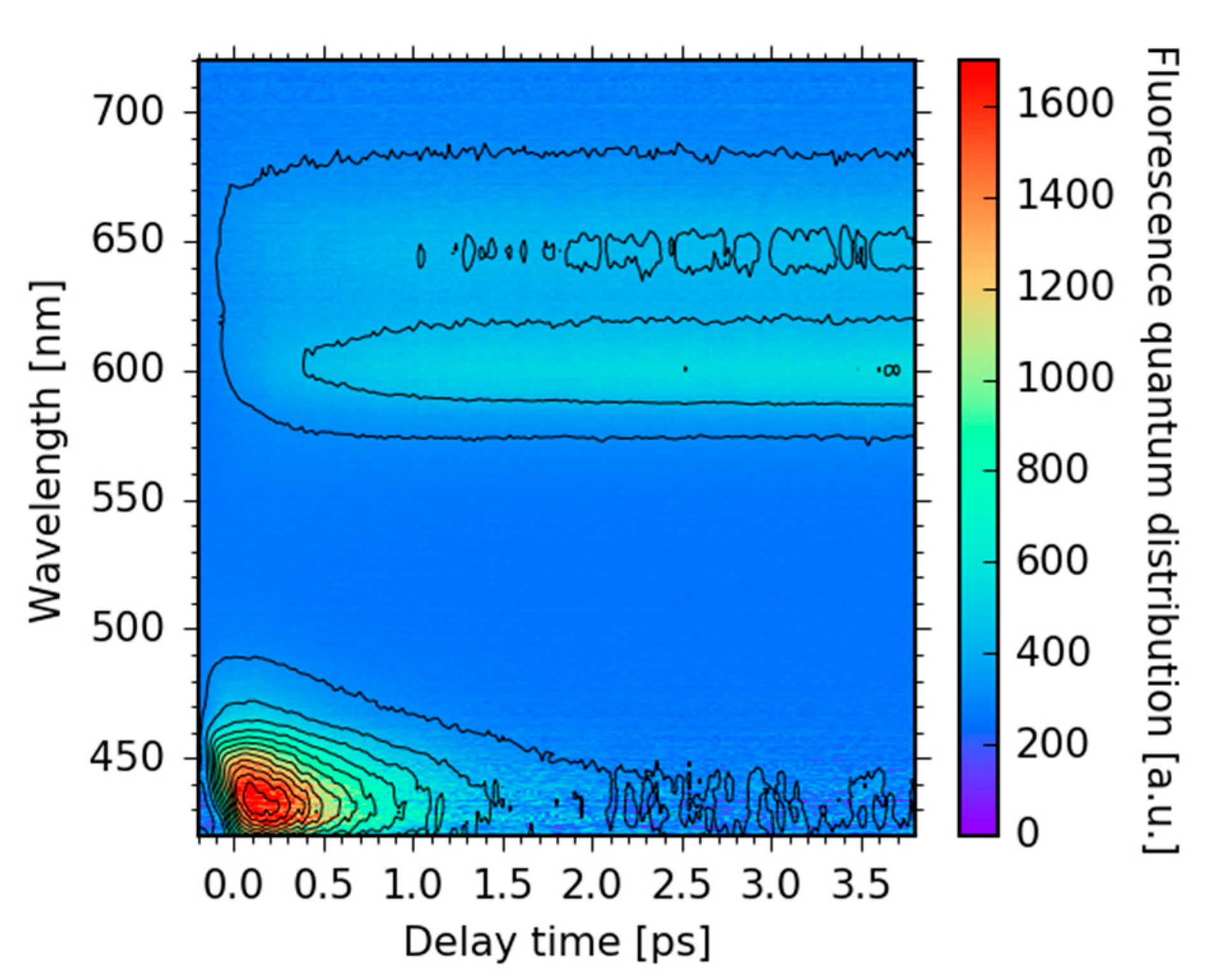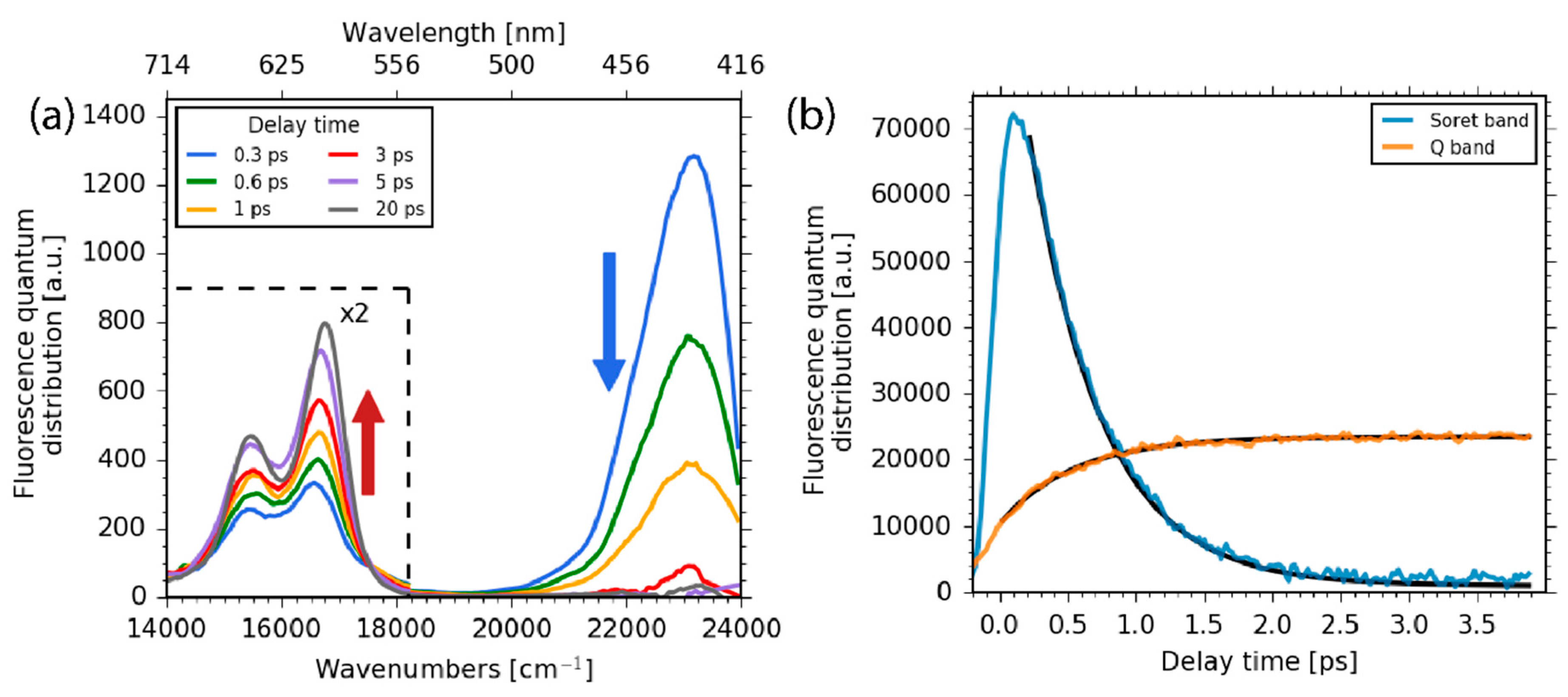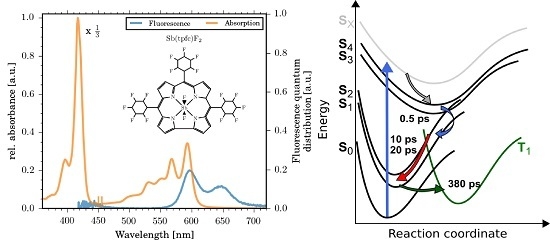Ultrafast Dynamics of Sb-Corroles: A Combined Vis-Pump Supercontinuum Probe and Broadband Fluorescence Up-Conversion Study
Abstract
:1. Introduction
2. Results
2.1. Transient Fluorescence Measurements
2.2. Transient Absorption Measurements
2.3. Global Analysis
3. Discussion
4. Materials and Methods
Acknowledgments
Author Contributions
Conflicts of Interest
References
- Aviv, I.; Gross, Z. Corrole-based applications. Chem. Commun. 2007, 1987–1999. [Google Scholar] [CrossRef]
- Santos, C.I.M.; Barata, J.F.B.; Calvete, M.J.F.; Vale, L.S.H.P.; Dini, D.; Meneghetti, M.; Neves, M.G.P.M.S.; Faustino, M.A.F.; Tome, A.C.; Cavaleiro, J.A.S. Synthesis and functionalization of corroles. An insight on their nonlinear optical absorption properties. Curr. Org. Synth. 2014, 11, 29–41. [Google Scholar] [CrossRef]
- Voloshchuk, R.; Tasior, M.; Ciuciu, A.I.; Flamigni, L.; Gryko, D.T. Corrole-imide dyads—Synthesis and optical properties. J. Porphyr. Phthalocyanines 2015, 19, 479–491. [Google Scholar] [CrossRef]
- Wang, L.L.; Wang, H.; Cheng, F.; Liang, Z.H.; Liu, C.F.; Li, Y.; Wang, W.Q.; Peng, S.H.; Wang, X.; Ying, X.; et al. Investigation of excited-state photophysical properties of water soluble gallium corrole. J. Phys. Chem. C 2017, 121, 12350–12357. [Google Scholar] [CrossRef]
- Vestfrid, J.; Botoshansky, M.; Palmer, J.H.; Durrell, A.C.; Gray, H.B.; Gross, Z. Iodinated aluminum(III) corroles with long-lived triplet excited states. J. Am. Chem. Soc. 2011, 133, 12899–12901. [Google Scholar] [CrossRef] [PubMed]
- Wagnert, L.; Berg, A.; Stavitski, E.; Berthold, T.; Kothe, G.; Goldberg, I.; Mahammed, A.; Simkhovich, L.; Gross, Z.; Levanon, H. Exploring the photoexcited triplet states of aluminum and tin corroles by time-resolved Q-band epr. Appl. Magn. Reson. 2006, 30, 591–604. [Google Scholar] [CrossRef]
- Wagnert, L.; Rubin, R.; Berg, A.; Mahammed, A.; Gross, Z.; Levanon, H. Photoexcited triplet state properties of brominated and nonbrominated Ga(III)-corroles as studied by time-resolved electron paramagnetic resonance. J. Phys. Chem. B 2010, 114, 14303–14308. [Google Scholar] [CrossRef] [PubMed]
- Lemon, C.M.; Halbach, R.L.; Huynh, M.; Nocera, D.G. Photophysical properties of β-substituted free-base corroles. Inorg. Chem. 2015, 54, 2713–2725. [Google Scholar] [CrossRef] [PubMed]
- Brennan, B.J.; Lam, Y.C.; Kim, P.M.; Zhang, X.; Brudvig, G.W. Photoelectrochemical cells utilizing tunable corroles. ACS Appl. Mater. Interfaces 2015, 7, 16124–16130. [Google Scholar] [CrossRef] [PubMed]
- Ghosh, A. Electronic structure of corrole derivatives: Insights from molecular structures, spectroscopy, electrochemistry, and quantum chemical calculations. Chem. Rev. 2017, 117, 3798–3881. [Google Scholar] [CrossRef] [PubMed]
- Aviv-Harel, I.; Gross, Z. Coordination chemistry of corroles with focus on main group elements. Coord. Chem. Rev. 2011, 255, 717–736. [Google Scholar] [CrossRef]
- Palmer, J. Transition metal corrole coordination chemistry. In Molecular Electronic Structures of Transition Metal Complexes; Mingos, D.M.P., Day, P., Dahl, J.P., Eds.; Springer: Berlin/Heidelberg, Germany, 2012; Volume 142, pp. 49–89. [Google Scholar]
- Walker, D.; Chappel, S.; Mahammed, A.; Brunschwig, B.S.; Winkler, J.R.; Gray, H.B.; Zaban, A.; Gross, Z. Corrole-sensitized TiO2 solar cells. J. Porphyr. Phthalocyanines 2006, 10, 1259–1262. [Google Scholar] [CrossRef]
- Hwang, J.Y.; Lubow, D.J.; Sims, J.D.; Gray, H.B.; Mahammed, A.; Gross, Z.; Medina-Kauwe, L.K.; Farkas, D.L. Investigating photoexcitation-induced mitochondrial damage by chemotherapeutic corroles using multimode optical imaging. J. Biomed. Opt. 2012, 17, 015003. [Google Scholar] [CrossRef] [PubMed]
- Barata, J.F.B.; Zamarrón, A.; Neves, M.G.P.M.S.; Faustino, M.A.F.; Tomé, A.C.; Cavaleiro, J.A.S.; Röder, B.; Juarranz, Á.; Sanz-Rodríguez, F. Photodynamic effects induced by meso-tris(pentafluorophenyl)corrole and its cyclodextrin conjugates on cytoskeletal components of HeLa cells. Eur. J. Med. Chem. 2015, 92, 135–144. [Google Scholar] [CrossRef] [PubMed]
- Hwang, J.Y.; Lubow, D.J.; Chu, D.; Sims, J.; Alonso-Valenteen, F.; Gray, H.B.; Gross, Z.; Farkas, D.L.; Medina-Kauwe, L.K. Photoexcitation of tumor-targeted corroles induces singlet oxygen-mediated augmentation of cytotoxicity. J. Control. Release 2012, 163, 368–373. [Google Scholar] [CrossRef] [PubMed]
- Agadjanian, H.; Ma, J.; Rentsendorj, A.; Valluripalli, V.; Hwang, J.Y.; Mahammed, A.; Farkas, D.L.; Gray, H.B.; Gross, Z.; Medina-Kauwe, L.K. Tumor detection and elimination by a targeted gallium corrole. Proc. Natl. Acad. Sci. USA 2009, 106, 6105–6110. [Google Scholar] [CrossRef] [PubMed]
- Preuss, A.; Saltsman, I.; Mahammed, A.; Pfitzner, M.; Goldberg, I.; Gross, Z.; Roder, B. Photodynamic inactivation of mold fungi spores by newly developed charged corroles. J. Photochem. Photobiol. B 2014, 133, 39–46. [Google Scholar] [CrossRef] [PubMed]
- Pohl, J.; Saltsman, I.; Mahammed, A.; Gross, Z.; Roder, B. Inhibition of green algae growth by corrole-based photosensitizers. J. Appl. Microbiol. 2015, 118, 305–312. [Google Scholar] [CrossRef] [PubMed]
- Barata, J.F.B.; Pinto, R.J.B.; Serra, V.I.R.C.V.; Silvestre, A.J.D.; Trindade, T.; Neves, M.G.P.M.S.; Cavaleiro, J.A.S.; Daina, S.; Sadocco, P.; Freire, C.S.R. Fluorescent Bioactive Corrole Grafted-Chitosan Films. Biomacromolecules 2016, 17, 1395–1403. [Google Scholar] [CrossRef] [PubMed]
- Hwang, J.Y.; Wachsmann-Hogiu, S.; Ramanujan, V.K.; Ljubimova, J.; Gross, Z.; Gray, H.B.; Medina-Kauwe, L.K.; Farkas, D.L. A multimode optical imaging system for preclinical applications in vivo: Technology development, multiscale imaging, and chemotherapy assessment. Mol. Imaging Biol. 2012, 14, 431–442. [Google Scholar] [CrossRef] [PubMed]
- Luobeznova, I.; Raizman, M.; Goldberg, I.; Gross, Z. Synthesis and full characterization of molybdenum and antimony corroles and utilization of the latter complexes as very efficient catalysts for highly selective aerobic oxygenation reactions. Inorg. Chem. 2006, 45, 386–394. [Google Scholar] [CrossRef] [PubMed]
- Barata, J.F.B.; Daniel-da-Silva, A.L.; Neves, M.G.P.M.S.; Cavaleiro, J.A.S.; Trindade, T. Corrole-silica hybrid particles: Synthesis and effects on singlet oxygen generation. RSC Adv. 2013, 3, 274–280. [Google Scholar] [CrossRef]
- Reith, L.M.; Himmelsbach, M.; Schoefberger, W.; Knör, G. Electronic spectra and photochemical reactivity of bismuth corrole complexes. J. Photochem. Photobiol. A Chem. 2011, 218, 247–253. [Google Scholar] [CrossRef]
- Flamigni, L.; Gryko, D.T. Photoactive corrole-based arrays. Chem. Soc. Rev. 2009, 38, 1635–1646. [Google Scholar] [CrossRef] [PubMed]
- Giribabu, L.; Kandhadi, J.; Kanaparthi, R.K. Phosphorus(V)corrole-porphyrin based hetero trimers: Synthesis, spectroscopy and photochemistry. J. Fluoresc. 2014, 24, 569–577. [Google Scholar] [CrossRef] [PubMed]
- Giribabu, L.; Kandhadi, J.; Kanaparthi, R.K.; Reeta, P.S. Excitational energy and photoinduced electron transfer reactions in Ge(IV) corrole-porphyrin hetero dimers. J. Lumin. 2014, 145, 357–363. [Google Scholar] [CrossRef]
- Shi, L.; Liu, H.-Y.; Shen, H.; Hu, J.; Zhang, G.-L.; Wang, H.; Ji, L.-N.; Chang, C.-K.; Jiang, H.-F. Fluorescence properties of halogenated mono-hydroxyl corroles: The heavy-atom effects. J. Porphyr. Phthalocyanines 2009, 13, 1221–1226. [Google Scholar] [CrossRef]
- Vestfrid, J.; Goldberg, I.; Gross, Z. Tuning the photophysical and redox properties of metallocorroles by iodination. Inorg. Chem. 2014, 53, 10536–10542. [Google Scholar] [CrossRef] [PubMed]
- Rabinovich, E.; Goldberg, I.; Gross, Z. Gold(I) and gold(III) corroles. Chem. Eur. J. 2011, 17, 12294–12301. [Google Scholar] [CrossRef] [PubMed]
- Palmer, J.H.; Day, M.W.; Wilson, A.D.; Henling, L.M.; Gross, Z.; Gray, H.B. Iridium corroles. J. Am. Chem. Soc. 2008, 130, 7786–7787. [Google Scholar] [CrossRef] [PubMed]
- Palmer, J.H.; Durrell, A.C.; Gross, Z.; Winkler, J.R.; Gray, H.B. Near-IR phosphorescence of iridium(III) corroles at ambient temperature. J. Am. Chem. Soc. 2010, 132, 9230–9231. [Google Scholar] [CrossRef] [PubMed]
- Shao, W.; Wang, H.; He, S.; Shi, L.; Peng, K.; Lin, Y.; Zhang, L.; Ji, L.; Liu, H. Photophysical properties and singlet oxygen generation of three sets of halogenated corroles. J. Phys. Chem. B 2012, 116, 14228–14234. [Google Scholar] [CrossRef] [PubMed]
- Mahammed, A.; Tumanskii, B.; Gross, Z. Effect of bromination on the electrochemistry, frontier orbitals, and spectroscopy of metallocorroles. J. Porphyr. Phthalocyanines 2011, 15, 1275–1286. [Google Scholar] [CrossRef]
- Zhang, L.; Liu, Z.-Y.; Zhan, X.; Wang, L.-L.; Wang, H.; Liu, H.-Y. Photophysical properties of electron-deficient free-base corroles bearing meso-fluorophenyl substituents. Photochem. Photobiol. Sci. 2015, 14, 953–962. [Google Scholar] [CrossRef] [PubMed]
- Kowalska, D.; Liu, X.; Tripathy, U.; Mahammed, A.; Gross, Z.; Hirayama, S.; Steer, R.P. Ground- and excited-state dynamics of aluminum and gallium corroles. Inorg. Chem. 2009, 48, 2670–2676. [Google Scholar] [CrossRef] [PubMed]
- Liu, X.; Mahammed, A.; Tripathy, U.; Gross, Z.; Steer, R.P. Photophysics of Soret-excited tetrapyrroles in solution. III. Porphyrin analogues: Aluminum and gallium corroles. Chem. Phys. Lett. 2008, 459, 113–118. [Google Scholar] [CrossRef]
- Mahammed, A.; Gross, Z. Metallocorroles as photocatalysts for driving endergonic reactions, exemplified by bromide to bromine conversion. Angew. Chem. Int. Ed. 2015, 54, 12370–12373. [Google Scholar] [CrossRef] [PubMed]
- Stensitzki, T.; Yang, Y.; Berg, A.; Mahammed, A.; Gross, Z.; Heyne, K. Ultrafast electronic and vibrational dynamics in brominated aluminum corroles: Energy relaxation and triplet formation. Struct. Dyn. 2016, 3, 043210. [Google Scholar] [CrossRef] [PubMed]
- Steene, E.; Wondimagegn, T.; Ghosh, A. Resonance raman spectroscopy and density functional theoretical calculations of manganese corroles. A parallelism between high-valent metallocorroles and metalloporphyrins, relevant to horseradish peroxidase and chloroperoxidase compound I and II intermediates. J. Inorg. Biochem. 2002, 88, 113–118. [Google Scholar] [PubMed]
- Mody, V.V.; Fitzpatrick, M.B.; Zabaneh, S.S.; Czernuszewicz, R.S.; Gałęzowski, M.; Gryko, D.T. Solvent effects on the electronic and vibrational properties of high-valent oxomolybdenum(V) 5,10,15-triphenylcorrole probed by UV-visible and resonance raman spectroscopy. J. Porphyr. Phthalocyanines 2009, 13, 1040–1052. [Google Scholar] [CrossRef]
- Halvorsen, I.; Steene, E.; Ghosh, A. Resonance Raman marker bands of β-octahalogeno-meso-tetraarylmetalloporphyrins. J. Porphyr. Phthalocyanines 2001, 5, 721–730. [Google Scholar] [CrossRef]
- Wasbotten, I.H.; Wondimagegn, T.; Ghosh, A. Electronic absorption, resonance raman, and electrochemical studies of planar and saddled copper(III) meso-triarylcorroles. Highly substituent-sensitive Soret bands as a distinctive feature of high-valent transition metal corroles. J. Am. Chem. Soc. 2002, 124, 8104–8116. [Google Scholar] [CrossRef] [PubMed]
- Yang, Y.; Jones, D.; von Haimberger, T.; Linke, M.; Wagnert, L.; Berg, A.; Levanon, H.; Zacarias, A.; Mahammed, A.; Gross, Z.; et al. Assignment of aluminum corroles absorption bands to electronic transitions by femtosecond polarization resolved Vis-pump IR-probe spectroscopy. J. Phys. Chem. A 2012, 116, 1023–1029. [Google Scholar] [CrossRef] [PubMed]
- Raavi, S.S.K.; Yin, J.; Grancini, G.; Soci, C.; Soma, V.R.; Lanzani, G.; Giribabu, L. Femtosecond to microsecond dynamics of Soret-band excited corroles. J. Phys. Chem. C 2015, 119, 28691–28700. [Google Scholar] [CrossRef]
- Nastasi, F.; Campagna, S.; Ngo, T.H.; Dehaen, W.; Maes, W.; Kruk, M. Luminescence of meso-pyrimidinylcorroles: Relationship with substitution pattern and heavy atom effects. Photochem. Photobiol. Sci. 2011, 10, 143–150. [Google Scholar] [CrossRef] [PubMed]
- Wagnert, L.; Berg, A.; Stavitski, E.; Luobeznova, I.; Gross, Z.; Levanon, H. Structure-function relationship in antimony corrole photosensitizers. Time-resolved electron paramagnetic resonance and optical study. J. Porphyr. Phthalocyanines 2007, 11, 645–651. [Google Scholar] [CrossRef]
- Sajadi, M.; Quick, M.; Ernsting, N.P. Femtosecond broadband fluorescence spectroscopy by down- and up-conversion in β-barium borate crystals. Appl. Phys. Lett. 2013, 103, 173514. [Google Scholar] [CrossRef]
- Knyukshto, V.N.; Ngo, T.H.; Dehaen, W.; Maes, W.; Kruk, M.M. Phosphorescence of free base corroles. RSC Adv. 2016, 6, 43911–43915. [Google Scholar] [CrossRef]
- Mizutani, Y.; Kitagawa, T. Direct observation of cooling of heme upon photodissociation of carbonmonoxy myoglobin. Science 1997, 278, 443–446. [Google Scholar] [CrossRef] [PubMed]
- Stensitzki, T.; Muders, V.; Schlesinger, R.; Heberle, J.; Heyne, K. The primary photoreaction of channelrhodopsin-1: Wavelength dependent photoreactions induced by ground-state heterogeneity. Front. Mol. Biosci. 2015, 2, 41–51. [Google Scholar] [CrossRef] [PubMed]
- Zhao, L.J.; Lustres, J.L.P.; Farztdinov, V.; Ernsting, N.P. Femtosecond fluorescence spectroscopy by upconversion with tilted gate pulses. Phys. Chem. Chem. Phys. 2005, 7, 1716–1725. [Google Scholar] [CrossRef] [PubMed]
- Zhang, X.X.; Wurth, C.; Zhao, L.; Resch-Genger, U.; Ernsting, N.P.; Sajadi, M. Femtosecond broadband fluorescence upconversion spectroscopy: Improved setup and photometric correction. Rev. Sci. Instrum. 2011, 82, 063108. [Google Scholar] [CrossRef] [PubMed]
- Gerecke, M.; Bierhance, G.; Gutmann, M.; Ernsting, N.P.; Rosspeintner, A. Femtosecond broadband fluorescence upconversion spectroscopy: Spectral coverage versus efficiency. Rev. Sci. Instrum. 2016, 87, 053115. [Google Scholar] [CrossRef] [PubMed]
Sample Availability: Samples of the compound Sb-tpfc-F2 are available from Zeev Gross and Atif Mahammed. |









© 2017 by the authors. Licensee MDPI, Basel, Switzerland. This article is an open access article distributed under the terms and conditions of the Creative Commons Attribution (CC BY) license (http://creativecommons.org/licenses/by/4.0/).
Share and Cite
Zahn, C.; Stensitzki, T.; Gerecke, M.; Berg, A.; Mahammed, A.; Gross, Z.; Heyne, K. Ultrafast Dynamics of Sb-Corroles: A Combined Vis-Pump Supercontinuum Probe and Broadband Fluorescence Up-Conversion Study. Molecules 2017, 22, 1174. https://doi.org/10.3390/molecules22071174
Zahn C, Stensitzki T, Gerecke M, Berg A, Mahammed A, Gross Z, Heyne K. Ultrafast Dynamics of Sb-Corroles: A Combined Vis-Pump Supercontinuum Probe and Broadband Fluorescence Up-Conversion Study. Molecules. 2017; 22(7):1174. https://doi.org/10.3390/molecules22071174
Chicago/Turabian StyleZahn, Clark, Till Stensitzki, Mario Gerecke, Alexander Berg, Atif Mahammed, Zeev Gross, and Karsten Heyne. 2017. "Ultrafast Dynamics of Sb-Corroles: A Combined Vis-Pump Supercontinuum Probe and Broadband Fluorescence Up-Conversion Study" Molecules 22, no. 7: 1174. https://doi.org/10.3390/molecules22071174





